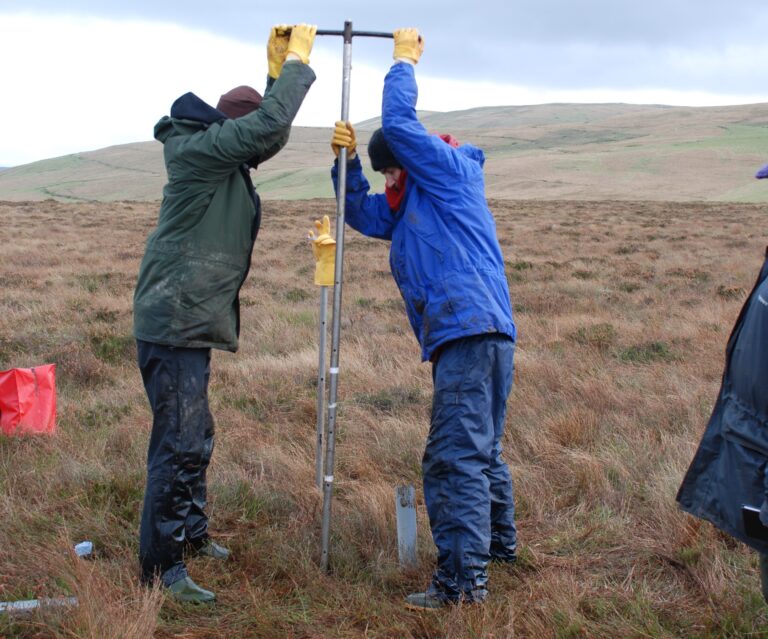Project Description
Past climate change can be reconstructed through the investigation of a variety of archives (proxies) such as ice cores, lake sediments and peatlands. These can be used to establish records of climate change at hemispheric, regional, and local spatial scales and over millennial to decadal timescales. Proxy measures allow us to extend climatic records beyond historical documents (as proxies can act as a measure for climate change when direct measurements cannot be made). These records are of value in reconstructing climate changes during our current warm period (the Holocene epoch) and in providing a spatial and temporal perspective for recent climatic warming and its impact. Regional and local climate reconstructions provide further information on climatic variability and responses by humans, and other environmental parameters such as biodiversity. To do produce this information effectively the methods used must be validated to understand their strengths and weaknesses, as all current established techniques have (different) strengths and weaknesses. To ensure their validity, the techniques used to collect accurate and reliable data need to be replicated and emerging ones such as non-pollen palynomorphs [NPPs] and Fourier Transform Infrared Spectroscopy ([FTIR] need to be rigorously tested. Thus, the aims of this proposal are to (1) reconstruct climatic variability during the Late Holocene using peatland archives; and (2) to test the viability of emerging techniques (NPPs, FTIR) as proxy climatic indicators alongside more tried and tested ones. To do so, the project will identify several ombrotrophic (rain-fed) peatlands in Ireland and Scotland that are suitable to reconstruct climate change and collect core samples for laboratory analysis. Blanket bogs are more common than raised bogs in the UK, so they will be better for the applied conservation part of this research. Raised bogs offer ‘better’ proxy-climate archives as the preservation of the proxies is usually better. Primary focus of the project will be upon indicator species that reflect past environmental changes within a study site or region. The student will apply well-established and reliable proxies, namely the analysis of plant macrofossils and testate amoebae, which have been widely used to reconstruct climate changes such as the Holocene thermal maximum and the Little Ice Age, and more abrupt climate shifts due to changes caused by the North Atlantic Oscillation c. 4500 years ago. They will act as a control to test the efficacy of relatively unexplored and emerging methods (NPPs, FTIR). Testing the validity of emerging methods is important as they can improve the reliability of reconstructions of past climate and environmental disturbance. To establish their reliability the datasets will be compared to the tried and tested methods reinforced by statistical methods including multivariate ordination techniques, the use of transfer functions and changepoint analysis. The chronology of each core will be established by AMS radiocarbon dating, tephrochronology, and age-depth modelling. These records should prove valuable in terms of contributing to our understanding of the key processes and uncertainties linked to climate change and in characterising human behavioural responses to climate change by past cultures.
CANDIDATE BACKGROUND
Essential skills: Scientific data production, understanding of climate change, data analysis, palaeoecology
Desirable skills/experience: Analysis of microfossils, statistics
Photo credit: Timothy Mighall, University of Aberdeen
Supervisors
Tim MighallPrimary Supervisor: | Profile: Tim Mighall Email: t.mighall@abdn.ac.uk Institution: University of Aberdeen Department/School: School of Geosciences |
Graeme SwindlesSecondary Supervisor: | Profile: Graeme Swindles Email: g.swindles@qub.ac.uk Institution: Queen's University, Belfast Department/School: School of Natural and Built Environment |
Dmitri MauquoyAdditional Supervisor: | Profile: Dmitri Mauquoy Email: d.mauquoy@abdn.ac.uk Institution: University of Aberdeen Department/School: School of Geosciences |
Ed SchofieldAdditional Supervisor: | Profile: Ed Schofield Email: j.e.schofield@abdn.ac.uk Institution: University of Aberdeen Department/School: School of Geosciences |
Gill PlunkettAdditional Supervisor: | Profile: Gill Plunkett Email: g.plunkett@qub.ac.uk Institution: Queen's University, Belfast Department/School: School of Natural and Built Environment |
Additional Supervisor: | Antonio Martinez Cortizas, CRETUS, EcoPast (GI-1553), Facultade de. Bioloxía, Santiago de Compostela, Spain |
References
Chambers, F.M., Booth, R.K., De Vleeschouwer, F., Lamentowicz, M., Le Roux, G., Mauquoy, D., Nichols, J.E. and van Geel, B., 2012. Development and refinement of proxy-climate indicators from peats. Quaternary International, 268, pp.21-33.
Martínez Cortizas, A., López-Merino, L., Silva-Sánchez, N., Sjöström, J.K. and Kylander, M.E., 2021. Investigating the mineral composition of peat by combining FTIR-ATR and multivariate analysis. Minerals, 11(10), p.1084.
Shumilovskikh, L.S., van Geel, B. (2020). Non-Pollen Palynomorphs. In: Henry, A. (eds) Handbook for the Analysis of Micro-Particles in Archaeological Samples. Interdisciplinary Contributions to Archaeology. Springer, Cham. https://doi.org/10.1007/978-3-030-42622-4_4
QUADRAT Themes
- biodiversity
- earth-systems
- environmental-management






















































